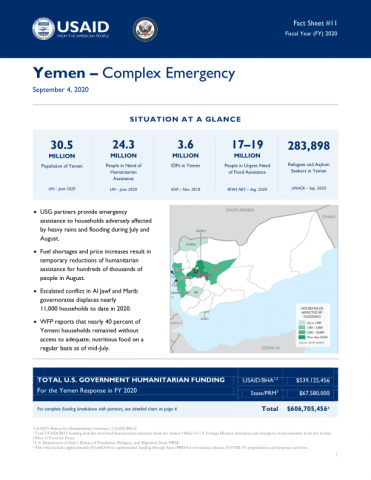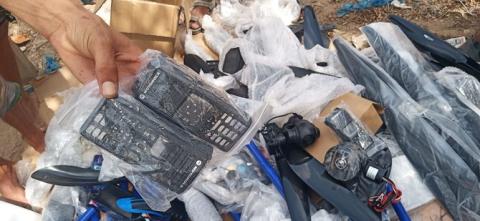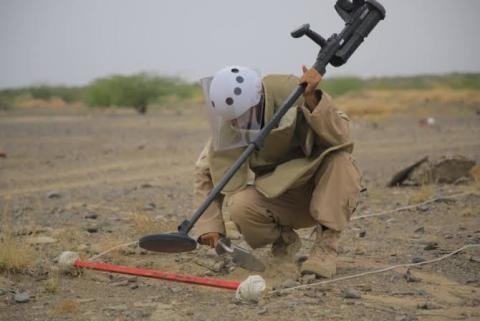Yemen Officially Has One of the Middle East's Lowest COVID-19 Counts. In Reality, the Virus Is Spreading Unseen and Unchecked


When international aid agency Doctors Without Borders took over management of the COVID-19 treatment center at a hospital in the Yemeni city of Aden on May 7, one of the immediate challenges was convincing cleaners, porters, and even some of the hospital’s doctors that the novel coronavirus existed, and could make them sick.
“After years of war, after years of having no proper services, people in general don’t trust what the media says, and they don’t trust the authorities,” the center’s deputy project co-ordinator Mohammed Abdulrahim told TIME by phone from Aden on May 24. “At the beginning, we had medical staff getting sick. They had direct contact with patients without taking precautions like putting on masks—they just treated it like a normal disease.”
Staff misperceptions of COVID-19 were just one of the obstacles Abdulrahim and his team faced. Before Doctors Without Borders (MSF) took over the al-Amal facility’s management there was no dedicated ambulance for coronavirus patients, and a political dispute meant Yemen’s government had stopped paying staff salaries, leading to a wave of resignations. Three weeks into its tenure, dire shortages of PPE and oxygen remain, and dozens of MSF staff are off sick in Aden.
The frontline medics at al-Amal are just a handful of the people struggling to prop up a healthcare system devastated by more than five years of war. After Saudi Arabia, the UAE and other Arab nations intervened to drive Iran-backed Houthi rebels from Yemen’s capital Sana’a in 2015, Yemen’s civil conflict has left more than 100,000 people dead, displaced millions, and led to what the U.N. calls the world’s worst man-made humanitarian crisis.
Now, the coronavirus is here and spreading silently through the country. Although testing is almost non-existent, doctors at the only dedicated COVID-19 treatment center in Yemen’s south say they are struggling to cope with a 40% mortality rate and a growing caseload of patients. “The team is under permanent stress with staff missing or not trained enough,” Marc Schakal, MSF’s deputy operations manager for Yemen tells TIME by phone from Dubai. “There are very difficult clinical decisions to take for the doctors to make: We are obliged to set admission criteria based on age and chances of survival at the end.”
As harrowing as conditions are inside the treatment center, MSF doctors believe they are seeing “just the tip of the iceberg,” Shakal says, “We are really worried about much older people who are not able to reach the center, and who are dying in the community.”
“We don’t have visibility on the epidemiological curve”
Yemen’s official coronavirus caseload, among the lowest in the Middle East, is almost certainly misleading. As of May 28, the World Health Organization had recorded only 253 confirmed cases and 50 deaths among a population of 28 million. In neighboring Oman, authorities have confirmed over 8,000 cases with a population one-sixth the size.
The country has a miniscule casecount only because of the near-total absence of testing. So far, authorities have performed fewer than 1,000 COVID-19 tests, or 31 per 1 million citizens. That’s a lower per capita figure than in northeast Syria, Chad, or Idlib.
The observations of doctors at al-Amal’s COVID treatment center cast further doubt on official figures. Between April 30 and May 24, the center admitted 228 patients suffering from coronavirus-like symptoms. Of those patients, 99 have died, or more than 40%. With the center permanently full, MSF is now expanding capacity to a total of 80 beds, up from 50 when it took over on May 7.
Facilities like this are desperately needed in a country with a barely functioning healthcare system. Half of the country’s hospitals and clinics have been destroyed or shut over the course of the war, and earlier this month, the Associated Press reported that 18% of Yemen’s 333 districts do not have a single doctor. The splintered country, which is controlled by various armed factions, is not anywhere close to being equipped to deal with an epidemic —according to a May 18 UNOCHA situation report, Yemen currently has fewer than 150 ventilators, about 500 ICU beds, and only five labs capable of conducting COVID-19 tests.
In Aden “some hospitals have closed because they’re worried about contamination, or because of lack of essential supplies that could protect the health of workers,” says MSF’s Schakal. Others have reportedly turned away patients who have sought help for breathing difficulties.
Although the MSF center still lacks sufficient staff numbers and PPE, oxygen is its most urgent need. Every day, the agency says, its COVID-19 center gets through 250 40-liter oxygen cylinders. Yemen has a total stockpile of under 12,000 cylinders for the entire country.

Yemeni officials on Monday condemned arrests and prosecutions by the Iran-backed Houthi militia directed against media, journalists and celebrities…

Yemen's warring parties are gearing up for new waves of conflict in 2023 amid a lack of decisive steps towards sustainable peace, adding to the suf…

The UAE will help to recruit doctors and deliver crucial supplies for hospitals in Yemen under a major healthcare drive. The Khalifa bin…